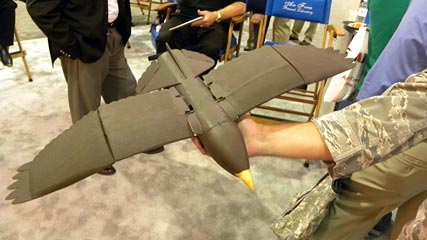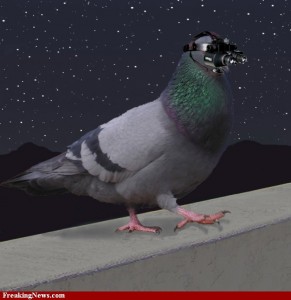
A prototype of the Air Force Research Laboratory's bird-like micro air vehicle is shown. Researchers say the so-called spy pigeon will flap its wings like a real bird, and even be able to land on power lines.
I’m always impressed by the amazing advances in technology we see from day to day. Computers and robots can do so much more than even those of us who are science-fiction fans ever conceived of years ago.
Take, for example, the “spy pigeon” aerial drone. This amazing little aircraft could save lives, or it could mean the end of privacy. Here’s the story from AOL News:
>>In the run-up to the invasion of Iraq, U.S. officials often had to rely on grainy satellite photos to decide whether facilities on the ground were intended for producing weapons of mass destruction. Now imagine that instead of overhead satellite imagery–or even high-flying unmanned aircraft–they could send in a flock of microdrones that could actually fly right over, or even inside, such facilities.
Even better, these drones–equipped with chemical sensors that could pick up possible weapons work with near certainty–would resemble typical birds, like pigeons, making them nearly impossible to spot.
This high-tech spy vision is precisely what Air Force researchers are trying to build, and they believe such a microdrone is not only possible, but could be ready to fly in just five years.
“Ideally, it’ll be a bird-sized UAV [unmanned aerial vehicle], with the current goal being a pigeon,” Dr. Leslie Perkins, the lead for micro air vehicles at the Air Force Research Laboratory, told AOL News. The “birdlike” UAV would also be able to operate with minimal pilot intervention for up to a week at a time, she said.
The scenario that the Air Force envisions for its would-be spy pigeon is a cross between the high-tech military thrillers of Tom Clancy and the science-fiction novels of Isaac Asimov. It would fly with almost no human interaction and be equipped with advanced sensors capable of detecting nuclear, biological or chemical weapons.
To date, the prototype hasn’t progressed much beyond the world of RadioShack, which sells a variety of animal-inspired toy planes, such as a flying bat. The Air Force Research Lab recently displayed a prototype of its bird, built by Ohio-based Theiss Aviation, at a trade show in Florida.
Though the bird is supposed to eventually have flapping wings, the current model has fixed wings with a push propeller in back; it has flown for about half an hour in a test facility.
 Air Force researchers hope that in a few years, however, the bird will look and fly like a real pigeon–and even perch inconspicuously on power lines to recharge. While there are a number of universities and companies working on micro air vehicles, the Air Force Research Lab has laid out a specific goal to field a bird-inspired drone by 2015, and then one based on an insect by 2030.
Air Force researchers hope that in a few years, however, the bird will look and fly like a real pigeon–and even perch inconspicuously on power lines to recharge. While there are a number of universities and companies working on micro air vehicles, the Air Force Research Lab has laid out a specific goal to field a bird-inspired drone by 2015, and then one based on an insect by 2030.
As part of its research, the Air Force Research Lab in May officially opened a $1.5 million testing facility, called the micro-aviary, dedicated specifically for micro air vehicles. Perkins, who helps coordinate researchers’ work across the lab’s various locations, says everyone knows that they are pushing the envelope on technology.
Among the challenges faced with micro air vehicles, for example, is finding a power source that is small yet powerful enough to provide the drones with endurance. Though a number of private companies build micro air vehicles, like AeroVironment’s WASP drone, they can typically only fly for less than an hour.
The Air Force Research Lab, by comparison, wants its micro air vehicle to operate for a week at a stretch. “When you talk with private firms, they don’t necessarily laugh, but they do realize that’s a holy grail,” Perkins said.
The pigeon drone builds on a growing interest in biometrics, which draws on nature to inspire technology. In the case of robots and drones, this means studying everything from spiders to hummingbirds to understand how they move.
At Brown University, aerospace engineer Kenneth Breuer has been studying bats, which are able to fly flawlessly through complex obstacles and tight spaces, such as in a cave. Breuer is looking at ways to better understand the physics and dynamics of the way bats fly, including their ability to flip themselves upside down to land.
“They do pretty remarkable things and we’re interested in understanding how they do it,” Breuer told AOL News.
Though Breuer thinks bat (or bird) flight may hold lessons for engineering, that doesn’t mean that animal- or insect-inspired flight would necessarily always make for the best sort of drone. “[Living things] are optimized for evolutionary survival, not for a particular engineering mission,” he said.
Mark Lewis, an aerospace engineer at the University of Maryland and former Air Force chief scientist, agrees that biomimetics, though good science, may not always trump traditional engineering and says it’s wrong to assume that just copying nature is always the right answer.
“Nature,” Lewis said, “never evolved a spinning rotor.”<<
All they need to do is insert some actual bird droppings that the drone could release occasionally, and no one would be able to tell the difference!
Here’s a video commentary on this very subject:
« Are Americans Turning Off Their TVs? ‘Barefoot Bandit’ No Longer A Step Ahead Of The Law »
